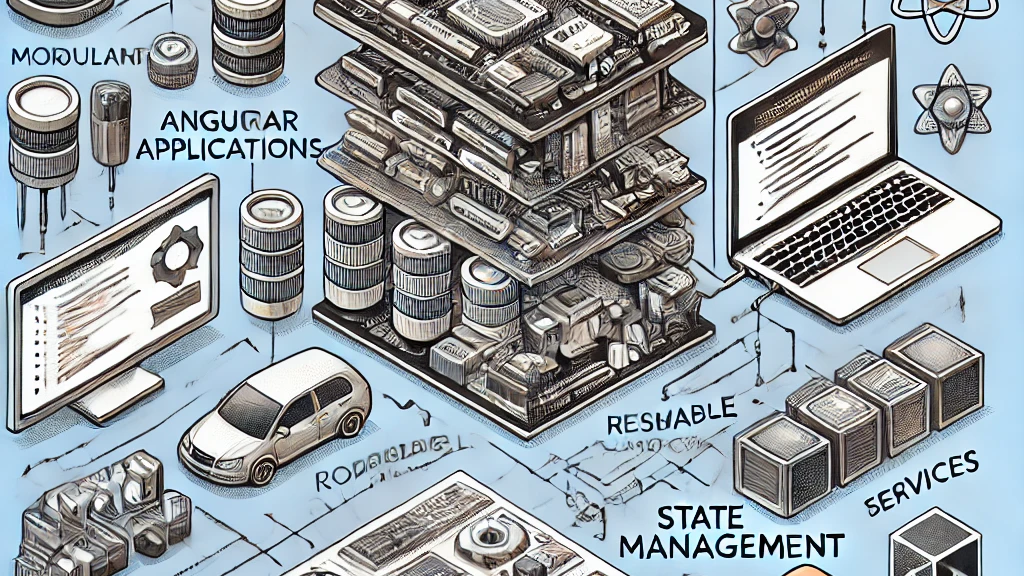Building Scalable and Maintainable Front-End Applications in 2025
Explore modern front-end architecture principles and Angular strategies for building scalable, maintainable, and efficient large-scale applications in 2025.

Front-end development continues to evolve at a rapid pace. As 2025 unfolds, the construction of scalable and maintainable architectures remains a central focus. With Angular’s cutting-edge features—including standalone components and signals—alongside broader front-end trends such as micro front-ends, AI integration, and composable design systems, developers are equipped with a diverse set of tools. This article outlines modern strategies and best practices for crafting robust front-end applications that are prepared to meet the demands of the future.
Shifts in Front-End Development

In recent years, front-end architectures have transitioned from tightly coupled, monolithic applications to modular, reusable, and composable designs. This evolution has been largely driven by frameworks like Angular, React, and Vue, which promote a component-based approach. As of 2025, standalone components, micro front-ends, and refined tooling are further streamlining workflows and enhancing developer productivity. The simplification of dependency management, a focus on feature-specific implementations, and the optimization of state updates are now standard practices.
Standalone components in Angular, while eliminating the need for NgModules in many scenarios, continue to demonstrate their effectiveness by streamlining dependency management. However, their utility does not entirely replace the use of NgModules in cases requiring complex dependency injection or global provider configurations. Similarly, Angular signals enhance the framework’s reactivity model, offering optimized state updates and reducing unnecessary rendering cycles. While signals are highly effective in straightforward scenarios, state management libraries like NgRx remain indispensable for addressing more complex requirements.
Building Blocks for 2025

Scalability is essential when handling growing user bases, and architectural decisions must support seamless scaling. Angular’s lazy-loading capabilities, which facilitate the on-demand loading of features, ensure that initial bundle sizes remain small and efficient. Modular development, complemented by micro front-end architectures, allows applications to be split into smaller, independently deployable modules. However, this approach introduces challenges such as dependency sharing and runtime communication that require thoughtful solutions.
Maintaining clean and organized code is critical for scalability. Standalone components help isolate logic and reduce tight coupling. While signals simplify state updates, they are best suited for simpler scenarios. More complex applications may require centralized state management solutions like NgRx. The consistent use of tools such as ESLint and Prettier enforces coding standards, ensuring that codebases remain maintainable as they grow.
Performance optimization has become increasingly significant as user expectations for fast-loading applications rise. Angular signals, by enabling fine-grained reactivity, help minimize unnecessary re-renders, thereby improving performance. Lazy loading and dynamic imports ensure that code and resources are only loaded when needed, reducing initial load times. For applications requiring enhanced time-to-interactive, server-side rendering (SSR) combined with edge deployments on platforms such as Vercel or Netlify is an effective strategy.
The security of front-end applications cannot be overlooked. Angular’s built-in protections, including strict template checks and content sanitization, safeguard against common vulnerabilities. The importance of regularly auditing dependencies using tools like Snyk or Dependabot cannot be overstated, as they ensure vulnerabilities are promptly addressed.
User experience (UX) remains a pivotal aspect of front-end design. The integration of Angular with modern design systems guarantees consistency, while Progressive Web Apps (PWAs) provide offline capabilities and faster load times. Accessibility is prioritized through adherence to WCAG guidelines and the use of testing tools such as Accessibility Insights and Pa11y.
Organizing Angular Applications for Large-Scale Development

The organization of Angular applications for large-scale development benefits from modular design, where applications are broken into libraries or modules. This approach allows teams to focus on specific features independently, without impacting the overall codebase. Angular libraries align with scalable design principles by promoting separation of concerns.
Standalone components have redefined Angular’s architecture by removing the reliance on NgModules for components, directives, and pipes. This change simplifies dependency management, streamlines code, and suits modular or micro front-end architectures. For instance, routing with lazy loading becomes straightforward when using standalone components:
const routes: Routes = [
{
path: "dashboard",
loadComponent: () =>
import("./dashboard.component").then((m) => m.DashboardComponent),
},
];Micro front-ends have gained prominence alongside standalone components, enabling teams to develop and deploy Angular applications independently. Tools like Webpack Module Federation facilitate the integration of these applications into larger solutions, while ensuring that the complexities of versioning and dependency sharing are effectively managed.
State management is another crucial consideration for large applications. While signals provide a simpler approach for state updates, libraries like NgRx and Akita remain relevant for centralized and highly predictable state management.
Emerging Trends

The role of artificial intelligence (AI) in front-end development is expanding rapidly. AI-powered tools such as GitHub Copilot have proven invaluable for generating boilerplate code, improving test coverage, and debugging. These tools enhance productivity and allow developers to focus on more complex tasks.
The adoption of modern build tools like Vite or Nx has improved the developer experience (DX), offering faster builds and optimized workflows. Monorepos, managed with tools like Nx or Turborepo, simplify dependency management and foster code reuse across projects.
The rise of Web3 and decentralized features, although still in the early stages, opens new pathways for integrating blockchain-based authentication and storage. Composable design systems, documented with tools like Storybook, ensure that UI patterns remain consistent and reusable, even as applications grow.
Final Thoughts
The future of front-end architecture lies in the continuous refinement of practices, the adoption of emerging technologies, and the delivery of exceptional user experiences. Angular’s evolving ecosystem, with its focus on standalone components, signals, and AI-driven automation, provides a solid foundation for building scalable and maintainable applications. By staying informed of Angular’s roadmap, experimenting with new features, and investing in testing and automation, developers can ensure that their applications remain prepared for the demands of 2025 and beyond.